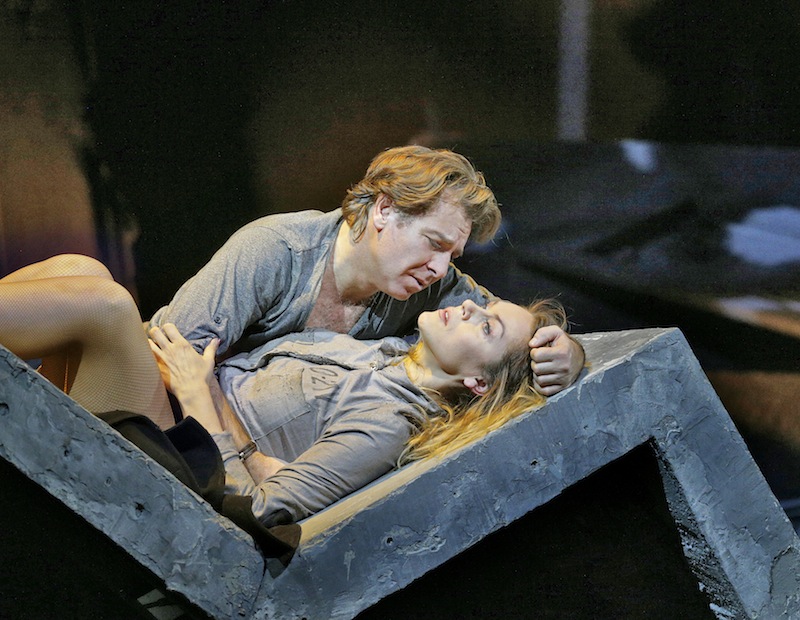Great performances vie with sophomoric staging in Met’s “Manon Lescaut”

Kristin Opolais and Roberto Alagna in the Metropolitan Opera production of Puccini’s “Manon Lescaut.” Photo: Ken Howard
One really ought never to insert Nazis into a dramatic piece that doesn’t specifically call for them. The Holocaust (and the European experience of Nazism generally) is such an emotionally laden, and emotionally specific, historical event that the drama ceases to be about anything else. It makes a cheap trick out of humanity’s darkest moment, playing on the audience’s preexisting notions about something totally unrelated to the drama itself.
For the Metropolitan Opera’s new production of Puccini’s Manon Lescaut, which opened Friday night, Sir Richard Eyre has preserved the original settings of Amiens and Paris, only moving the piece chronologically to 1941–an excuse to create a “film noir” take on the opera that is inescapably reminiscent of Casablanca. When Edmondo begins to sing in a bustling café that includes a table of German officers, it seems for a moment that he might launch into “La Marseillaise.”
And that scene is one of the dramatic high points of Eyre’s production. To be fair, the libretto itself is dramatically incoherent, skipping over crucial moments of character development in order to get to exciting plot points. In her dying moments, Manon asks Des Grieux to recall their happy months together–a period that we viewers never get to witness, as it falls between the first and second acts. And in many ways, the “bones” of the staging are quite solid: Rob Howell’s sets are handsomely crafted and evocative, particularly the third act, in which the prow of a ship looms menacingly over the stage, and the fourth, which–in a nice poetic touch–is set in the detritus of Act II’s lavish bedchamber.
But Eyre’s stage direction does little to illuminate the piece; many of his choices (the Nazis, especially) have a distinctly sophomoric feel, attempting ostentatiously to outwit both author and audience at every turn. No one suffers more than Kristine Opolais, an actress of immense talent, who in Act II is forced to play Manon as an arm-waving bimbo, frantically trying to gather up all of her pearls before making her escape.
Other decisions are just downright bizarre: Why did we have to see a tango danced to a minuet? Why does Des Grieux make his surprise entrance from the furniture closet? Why, at one of the most poignant moments in the opera, as Manon prepares to go into exile, do all of the other condemned streetwalkers put on a show of goofy slapstick antics while the company sings an aching farewell?
It is especially surprising to see such clumsy and tone-deaf directing from Eyre, whose previous Met engagements (Carmen, Werther, and Le Nozze di Figaro) have succeeded largely because of the truth and depth of their characterizations. His treatment of Manon Lescaut, by contrast, is almost comically shallow.
When left alone, the principal actors were in fact able to carve stunningly real portrayals. Opolais, though hamstrung during the second act, was devastating to watch in her final moments in Act IV. Her account of the celebrated aria “Sola, perduta, abbandonata” was uncommonly penetrating, a violent struggle for life. Where earlier her singing was mostly light and clear, in this final aria she was desperate, seemingly gasping for breath and sending shivers down the spine with a bristling chest voice.
One must give credit to Roberto Alagna–and the Met–for taking a considerable gamble, replacing an indisposed Jonas Kaufmann as Des Grieux with only weeks to learn the part. The effects of that last-minute swap can certainly be detected, as he had to keep at least one eye on the conductor throughout the performance and sounded strained in the upper reaches of what is not a particularly high part. One might have wished for his “Donna non vidi mai” to be a little more legato. Still, his is a voice of beautiful color, which he wielded brilliantly in a passionate portrayal.
The supporting cast has relatively few moments to shine, but were consistently strong nonetheless. Zach Borichevsky’s singing was firm and bright in his company debut as Edmondo. Brindley Sherratt, playing Geronte as some sort of grimy Nazi collaborator, had a voice to match, a deep, rough instrument that sets a listener on edge. Massimo Cavalletti barked a bit as Lescaut, though at his best he showed a fine, chocolate tone. The real stand-outs of the supporting characters were the nameless ones: Andrew Bidlack, showing a bright, easy tone as the street sweeper, and Virginie Verrez, sounding lovely and fresh as the leader of the madrigal singers.
But the true star of the evening, musically speaking, was the orchestra, under the superb direction of Fabio Luisi. This was the among the fiercest, most vigorous conducting that he has given at the Met to date, perfectly shaping the score to meet the piece’s dramatic demands and drawing out sounds that were alternately luminous and ferocious. And given the circumstances, the performance was admirably tight–one imagines that Alagna’s vocal performance will only improve from here. Too bad the same can’t be said for the staging.
Manon Lescaut runs through March 11 at the Metropolitan Opera. metopera.org